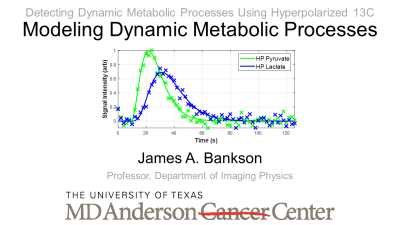Weekday Course
Detecting Dynamic Metabolic Processes Using Hyperpolarized 13C
Joint Annual Meeting ISMRM-ESMRMB & ISMRT 31st Annual Meeting • 07-12 May 2022 • London, UK

| Hyperpolarization I | |||
| 17:00 | Hyperpolarization Methods: dDNP, SEOP, PHIP & Co
Ilwoo Park
|
||
| 17:30 | Hyperpolarized 13C Metabolic Imaging Acquisition Methods
Jeremy Gordon
Hyperpolarized 13C MRI has emerged as a novel non-invasive imaging technique to assess metabolism in-vivo. However, hyperpolarized contrast agents have unique properties that require specialized imaging methods. Data acquisition strategies must account for the lower 13C gyromagnetic ratio, encode spectroscopic information, and acquire dynamic and volumetric data quickly relative to metabolism and T1 relaxation. This talk will describe the state-of-the-art in fast imaging methods for hyperpolarized 13C MRI, including the tradeoffs between the three major categories of fast imaging methods - spectroscopic imaging, model-based strategies, and metabolite specific imaging – and will discuss the RF pulses that enable these acquisition strategies. |
||
| Hyperpolarization II | |||
| 18:00 |  |
Modelling Dynamic Metabolic Processes
James Bankson
Hyperpolarized (HP) imaging agents such as [1-13C]-pyruvate can provide unique insight into metabolic processes in vivo. The pharmacokinetics of HP imaging agents are affected by metabolic and other characteristics of the biological system. Signal evolution is also modified by spin-lattice relaxation and by excitation pulses that are necessary for sampling data. Pharmacokinetic (PK) models offer a framework for explaining signal evolution, quantifying metabolic characteristics, and optimizing data acquisition and analysis strategies. In this lecture, we will derive extensible PK models for HP imaging agents, review simplifying assumptions, and demonstrate their utility for optimizing acquisitions and reducing errors in quantification.
|
|
| 18:30 | Is 13C Ready for the Clinic? Consensus & Standardization
Michael Ohliger
|
||
The International Society for Magnetic Resonance in Medicine is accredited by the Accreditation Council for Continuing Medical Education to provide continuing medical education for physicians.